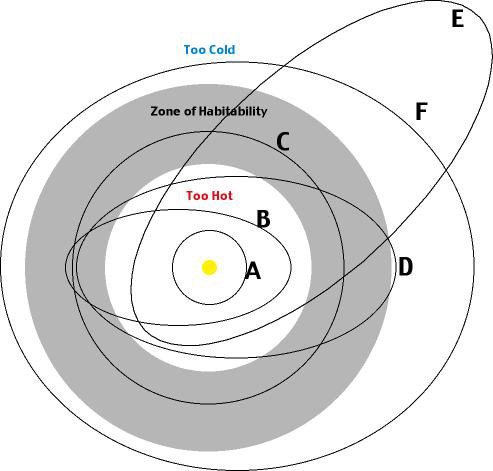The orbits of planets could potentially help determine if life can develop and survive on a planet.
For example, if a planet circles a star with a very tight circular orbit as shown by orbit A below, then the planet would become too hot for live to develop and survive.
A highly elliptical orbit that was close to the star, as in orbit B below, might be better -- it could even pass into the Zone of Habitability -- but would still be too hot for life. In addition, the elliptical orbit would stress the crust of the planet much more than a circular orbit and could lead to more tectonic activity such as earthquakes.
An orbit, such as the circular orbit C, would be far enough from the star to be warmed from the sun, but not too far that it would get too cold. It would be within a range of distances that would allow life to begin and survive. This is range of distances is called the "Zone of Habitability".
An elliptical orbit that falls mostly in the Zone of Habitability -- such as orbit D -- would still allow life to start and survive. However, tectonic activity such as earthquakes and volcanic eruptions would likely be greater.
An orbit such as F would lie too far from the star for life to begin and survive. The planet would be to cold for life to start on its own and survive.
An orbit such a E might lie within the Zone of Habitability for much of its orbit. However, life might find this orbit creates too much stress on the planet during its perihelion or aphelion -- the closest and furthest approaches to the star. In addition, if the planet in orbit E was massive enough, it could cause the star to be unstable. This could lead to periodic massive coronal mass ejections and superflares that could destroy life on orbiting planets.

Some planets and moons, like Jupiter and Saturn, generate more heat than they absorb from their star(s). In such cases, the Zone of Habitability would be expanded. Of course if a planet or moon is colonized by intelligent life with the proper technology, life could survive outside of the normal Zone of Habitability.
The simple distance from the star, and the orbital geometry, are not the only factors that affect the Zone of Habitability. If a planet or moon had a large atmosphere or ocean this could affect the situation. Also, a star might not be as stable as our sun. It could go through periods of instability that could reduce the Zone of Habitability.